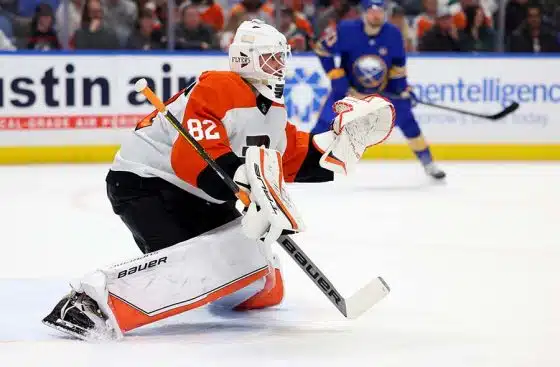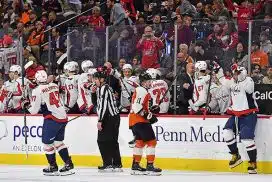When the Flyers were on the clock with the 18th overall pick on Friday night at the NHL Draft, they seemingly had the answer to all their goal scoring problems at their fingertips.
Kieffer Bellows, who scored 50 goals for the US U-18 team last season, was on the board. So was Julien Gauthier, who scored 41 goals for Val d'Or in the QMJHL last season. The Flyers opted to trade down instead, drafting German Rubtsov with the 22nd overall pick. Bellows went 19th to the Islanders, Gauthier 21st to the Hurricanes. The Flyers added a third second-round pick to their plethora of picks for Day 2, however.
In Saturday's Day 2 portion of the Draft, the Flyers were on the clock at 36th overall with another 50-goal scorer on the board, Alex DeBrincat, who scored 51 goals for the Erie Otters last season. The Flyers selected Pascal Laberge instead.
In both cases, the Flyers opted for the players that had better rounded games and potential to be complete two-way players in the NHL rather than the pure scorers who could just as easily get lost in the shuffle of draft picks gone bad as much as they could turn out to be NHL superstars.
The simple fact about the draft is that no one knows what the future holds for any of these kids taken from picks 1 to 211, or even the ones that weren't selected. It's part of the reason why the Flyers have focused on depth and players with strengths at both ends of the ice, not just the ability to score goals. The other reason why the Flyers may have gone the two-way route and not the scoring route: the timing just wasn't right.
Consider where the Flyers are as a franchise right now: perhaps a little ahead of schedule by making the playoffs last season, but far from being one of the Eastern Conference's true contenders, at least when stacked up against the likes of the Pittsburgh Penguins, Tampa Bay Lightning and Washington Capitals.
What those teams have is what the Flyers lack, a pure goal scorer, and the Flyers did not address that need head-on in the Draft. Rather, they drafted for depth and potential rather than to directly fill a need.
Ultimately, what makes teams like the Penguins and Lightning so successful is the overall scoring depth they possess. Every team needs that Sidney Crosby type of player, the one who consistently pushes 30 to 40 goals per season and approaches the 100-point mark. Every team needs another player or two who can also score in high numbers, anywhere in the 25-50 range.
But what the Penguins also had that made them so successful and put them on a championship run was the depth past the top lines. For Pittsburgh, those three players are Crosby, Evgeni Malkin and Phil Kessel. Crosby scored 36 goals this season, Malkin had 27 and Kessel had 26. Additionally, Patric Hornqvist had 22 goals.
Beyond those top four, three other forwards had 10 goals — Chris Kunitz, Matt Cullen and Carl Hagelin. Three more — Nick Bonino, Eric Fehr and Conor Sheary — came close to hitting the double-digit goal mark. The Penguins also had a double-digit scorer in Kris Letang, who had 16 goals.
The best indicator for depth scoring comes from time on ice, the players who aren't placed in every key situation — like the power play — but still contributed. Crosby scored 36 goals, but also averaged over 20 minutes of ice time per game. Cullen scored 16 goals, averaging just under 14 minutes per game. Sheary scored seven goals in 44 games averaging under 10 minutes of ice time per game.
While the Penguins may have three natural goal-scorers, their depth didn't halt production and that's the place the Flyers are trying to get to. That's why when addressing forward depth, the Flyers were selecting players like Rubtsov, Laberge and Wade Allison — players who could become very nice compliment pieces even if they aren't the top-line sniper type the Flyers really need.
The Flyers also had a need to add players who both fit into Dave Hakstol's system and can place as much emphasis on the defensive game as the offense. Half of the battle for a contending team is keeping the puck out of the net, and as the playoffs wore on, the teams that did that best advanced the farthest.
Here's another reason the Flyers may have held off on a high-scoring prospect. In addition to the fact that the draft and prospect development is so unpredictable to begin with, keep in mind that adding Bellows or Gauthier wouldn't have done anything for the Flyers next season. It may not have done anything for them the season after that. The wait time and uncertainty of a prospect elevating to the top-six of the forward group won't suddenly help Claude Giroux, Wayne Simmonds or Jakub Voracek score more goals next season.
Think about the free agency period coming up right now. The top name on the market is arguably Steven Stamkos, a perennial 50-goal scorer, the exact type of player that Flyers would need to boost scoring. There's just one problem, Stamkos comes with a lofty price tag and the Flyers have limited cap space. Stamkos is going to go to a team that can both afford him and that has expectations of taking the next step now. Even if the Flyers were able to add a player of Stamkos' caliber for next season, it wouldn't suddenly vault the Flyers into the same class as the Penguins, Lightning or Capitals.
So while the idea of window shopping a goal-scorer like Stamkos or a strong offensive winger like Kyle Okposo or even a Loui Eriksson or David Backes is appealing, it's simply unrealistic because the Flyers aren't in a position to do it — both financially and logically.
It's not time for the Flyers to invest in players who can single-handedly change a game, not while on the border of playoff team and lottery pick. That time will come. It is instead a time for Ron Hextall and the Flyers to focus on adding depth at all positions to build the best team and find the perfect fit for a big scorer in free agency later.
Kevin Durso is managing editor for Flyerdelphia. Follow him on Twitter @Kevin_Durso.







